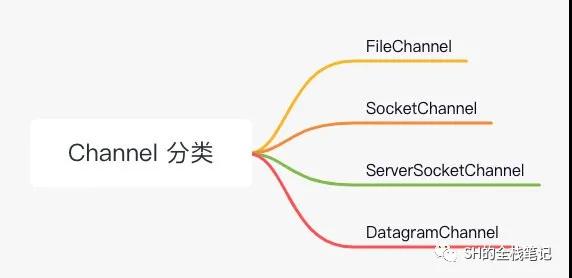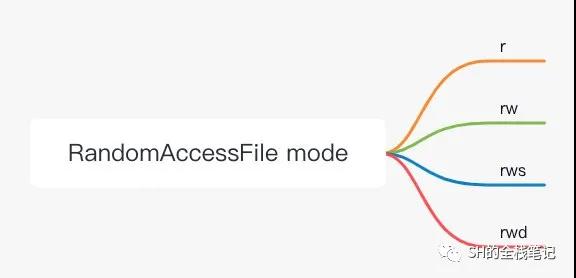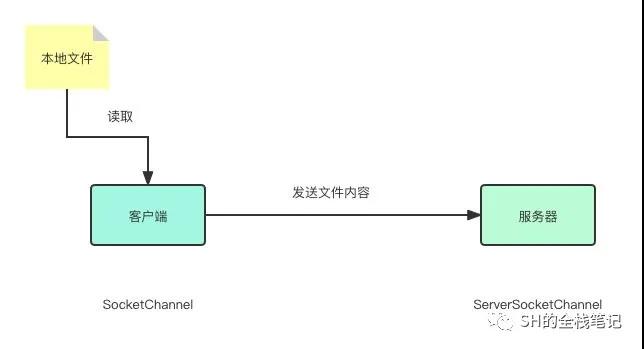本文转载自微信公众号「SH的全栈笔记」,作者SH的全栈笔记。转载本文请联系SH的全栈笔记公众号。
Java NIO 中的 Channel 分类:
- FileChannel
- SocketChannel
- ServerSocketChannel
- DatagramChannel
channel 分类
FileChannel: 主要用于文件的读写,可以从磁盘上读取文件,也可以向磁盘上写入文件。
SocketChannel:用于 Socket 的 TCP 连接的数据读写,既可以从 Channel 读数据,也可以向 Channle 中写入数据
ServerSocketChannel:通过 ServerSocketChannel 可以监听 TCP 连接,服务端监听到连接之后,会为每个请求创建一个 SocketChannel
DatagramChannel:用于 UDP 协议的数据读写
接下来就分别介绍一下。
FileChannel
主要用于操作文件,废话不多说,直接看例子。
准备文件 test-file.txt ,内容 shDEQuanZhanBiJi
test-file.txt 文件
输入 FileInputStream
用于从 FileChannel 中读取数据,例如将指定文件输入到 FileChannel 中,我们就能获取到文件的内容,接下来编写 FileChannel 的 输入流 核心代码:
- public static void main(String[] args) throws IOException {
- // 创建一个输入流
- FileInputStream fileInputStream = new FileInputStream("test-file.txt");
- // 通过输入流获取到 channel
- FileChannel fileChannel = fileInputStream.getChannel();
- // 准备好 ByteBuffer
- ByteBuffer buffer = ByteBuffer.allocate(16);
- // 将 输入流 的 channel 的数据读入 buffer 中
- fileChannel.read(buffer);
- // 简单打印 buffer 的内容
- printBuffer(buffer); // shDEQuanZhanBiJi
- }
这里面的 ByteBuffer 是 channel 进行读、写数据的中间媒介。要从 channel 中读取数据(也就是上面这个例子),需要先将数据读到 ByteBuffer 中;同理,要想向 channel 中写入数据,也需要先将数据写入 ByteBuffer(下面讲输出流的时候会讲)。
对 ByteBuffer 不熟悉的可以先看看我之前写的《玩转 ByteBuffer》,printBuffer 的代码里面也有
输出 FileOutputStream
顾名思义,是 FileChannel 要向外输出数据,例如将数据写入到磁盘文件上,接下来通过例子看看效果:
- public static void main(String[] args) throws IOException {
- // 指定需要生成的文件名称
- String generateFileName = "generate-file.txt";
- // 创建一个输出流
- FileOutputStream fileOutputStream = new FileOutputStream(generateFileName);
- // 通过输出流获取到 channel
- FileChannel fileChannel = fileOutputStream.getChannel();
- // 准备好 ByteBuffer, 并向里面写入数据
- ByteBuffer buffer = ByteBuffer.allocate(16);
- buffer.put("shDEQuanZhanBiJi".getBytes(StandardCharsets.UTF_8));
- // 将 输入流 的 channel 的数据读入 buffer 中
- fileChannel.write(buffer);
- fileChannel.close();
- }
相应的注释都已经贴在对应的代码上了,细节在此不再赘述。唯一需要关注的是,调用 write 写文件到磁盘上时,也是先传入的 ByteBuffer。
好了,当你运行完代码你会发现,虽然文件是生成的了,但是里面却是空白的...这其实就涉及到对 ByteBuffer 的熟悉程度了,算是埋的一个坑。
如果不知道为啥文件是空的,可以去看看上面讲 ByteBuffer 的文章,接下来是解答。
这是因为我们创建一个 ByteBuffer 的时候默认是处于写模式的,此时如果去通过 position 和 limit 去读取数据是读不到的。所以在调用 write 之前,我们需要先将 ByteBuffer 切换到读模式,完整代码如下:
- public static void main(String[] args) throws IOException {
- // 指定需要生成的文件名称
- String generateFileName = "generate-file.txt";
- // 创建一个输出流
- FileOutputStream fileOutputStream = new FileOutputStream(generateFileName);
- // 通过输出流获取到 channel
- FileChannel fileChannel = fileOutputStream.getChannel();
- // 准备好 ByteBuffer, 并向里面写入数据
- ByteBuffer buffer = ByteBuffer.allocate(16);
- buffer.put("shDEQuanZhanBiJi".getBytes(StandardCharsets.UTF_8));
- // 将 ByteBuffer 切换到读模式
- buffer.flip();
- // 将 输入流 的 channel 的数据读入 buffer 中
- fileChannel.write(buffer);
- fileChannel.close();
- }
可以看到,文件生成了,内容也有了:
但是呢,上面将的两种要么只能写,要么只能读。例如 FileInputStream 如果你硬要往 channel 里怼数据,程序最后会抛出 NonWritableChannelException 异常,告诉你这玩意儿写不了。
那有没有一个既能写,又能读还能唱跳的实现呢?当然有,那就是 RandomAccessFile。
这里提一嘴,调用完 write 并不是立即就写入磁盘,也可以在操作系统的缓存里。如果需要立即刷盘,则调用 channel.force(true); 即可。
RandomAccessFile
怎么用的呢?其实跟之前两个差不多:
- public static void main(String[] args) throws IOException {
- // 指定需要生成的文件名称
- String targetFileName = "target-file.txt";
- // 创建 RandomAccessFile, 赋予可读(r)、可写(w)的权限
- RandomAccessFile accessFile = new RandomAccessFile(targetFileName, "rw");
- FileChannel fileChannel = accessFile.getChannel();
- // 创建 ByteBuffer 并写入数据
- ByteBuffer buffer = ByteBuffer.allocate(16);
- buffer.put("shDEQuanZhanBiJi".getBytes(StandardCharsets.UTF_8));
- // 切换到 buffer 的读模式
- buffer.flip();
- // 调用 write 将 buffer 的数据写入到 channel, channel 再写数据到磁盘文件
- fileChannel.write(buffer);
- // 相当于清空 buffer
- buffer.clear();
- // 将之前写入到 channel 的数据再读入到 buffer
- fileChannel.read(buffer);
- // 打印 buffer 中的内容
- printBuffer(buffer);
- fileChannel.close();
- }
运行之后的效果就是,会生成一个名为 target-file.txt 的文件,内容就是 shDEQuanZhanBiJi。并且控制台会将之前写入 channel 的 shDEQuanZhanBiJi 打印出来。
老规矩,细节都在注释中。值得注意的是 new RandomAccessFile(targetFileName, "rw"); 里的 rw 。注释里也写了,代表赋予可读、可写的权限。
再值得注意的是,你不能说把 rw 改成 w。
不能这么玩,因为它就是一个单纯的字符串匹配,可供选择的就这么些:
mode 类型
- 可以看到,r 必不可少...:
- r 只能读
- rw 既能读,也能写
rws 和 rwd 功能和 rw 大致是相同的,可读、可写。唯一区别是他们会将每次改动强制刷到磁盘,并且 rws 会将操作系统对该文件的元数据也一起刷盘,体现就是文件的更新时间会更新,而 rwd 不会将文件的元数据刷盘
- 两个 SocketChannel
由于这俩一个负责连接传输,另一个负责连接的监听,所以就放在一起来讲了。这一小节我们大概要做这件事:
客户端发送文件到服务器
但是为了能让大家直接运行起来,客户端这侧就不从磁盘文件读取了,直接用 ByteBuffer。大家可以运行起来之后,自己尝试从磁盘上去加载。还是先看代码,首先是服务器的:
ServerSocketChannel
- public static void main(String[] args) throws IOException {
- // 打开一个 ServerSocketChannel
- ServerSocketChannel serverSocketChannel = ServerSocketChannel.open();
- // 绑定 8080 端口
- serverSocketChannel.bind(new InetSocketAddress(8080));
- // 开始接受客户端连接
- SocketChannel socketChannel = serverSocketChannel.accept();
- // 获取连接成功
- System.out.printf("socketChannel %s connected\n", socketChannel);
- // 准备 ByteBuffer 以从 socketChannel 中读取数据
- ByteBuffer buffer = ByteBuffer.allocate(16);
- // 开始读取数据
- System.out.println("before read");
- int read = socketChannel.read(buffer);
- System.out.printf("read complete, read bytes length: %s \n", read);
- printBuffer(buffer);
- }
这里我们使用的是 Java NIO 中默认的阻塞模式,仅仅作为一个掩饰,如果想要 ServerSocketChannel 进入非阻塞模式,可在 open 之后,调用:
- serverSocketChannel.configureBlocking(false);
由于我们这里是阻塞模式,所以在代码运行到 serverSocketChannel.accept(); 时,会陷入阻塞状态,直到有客户端过来建立连接。同理,read 方法也是阻塞的,如果客户端一直没有写入数据,那么服务器就会一直阻塞在 read 。
SocketChannel
直接先给代码:
- public static void main(String[] args) throws IOException {
- // 打开一个 SocketChannel
- SocketChannel socketChannel = SocketChannel.open();
- // 连接到 localhost 的 8080 端口
- socketChannel.connect(new InetSocketAddress("localhost", 8080));
- // 准备 ByteBuffer
- ByteBuffer buffer = ByteBuffer.allocate(16);
- buffer.put(Charset.defaultCharset().encode("test"));
- // 将 buffer 切换成读模式 & 向 channel 中写入数据
- buffer.flip();
- socketChannel.write(buffer);
- }
先启动服务器,再启动客户端。可以看到服务器侧的控制台有如下的输出:
- socketChannel java.nio.channels.SocketChannel[connected local=/127.0.0.1:8080 remote=/127.0.0.1:64373] connected
- before read
- read complete, read bytes length: 4
- BUFFER VALUE: test
Datagram
这个就比较简单,首先是客户端的代码:
- public static void main(String[] args) throws IOException {
- DatagramChannel datagramChannel = DatagramChannel.open();
- // 构建 buffer 数据
- ByteBuffer buffer = ByteBuffer.allocate(16);
- buffer.put(Charset.defaultCharset().encode("test"));
- // 切换到 buffer 的读模式
- buffer.flip();
- datagramChannel.send(buffer, new InetSocketAddress("localhost", 8080));
- }
然后是服务器:
- public static void main(String[] args) throws IOException {
- DatagramChannel datagramChannel = DatagramChannel.open();
- datagramChannel.bind(new InetSocketAddress(8080));
- ByteBuffer buffer = ByteBuffer.allocate(16);
- datagramChannel.receive(buffer);
- printBuffer(buffer);
- }










































